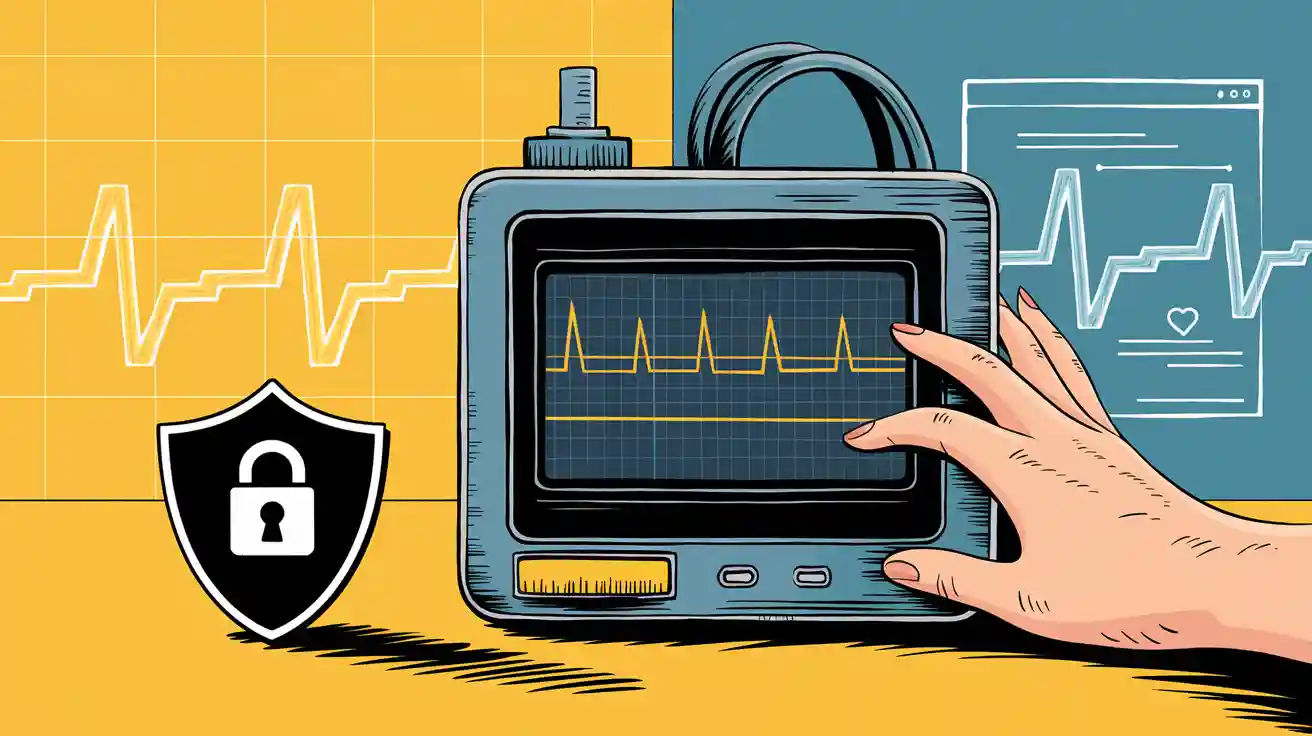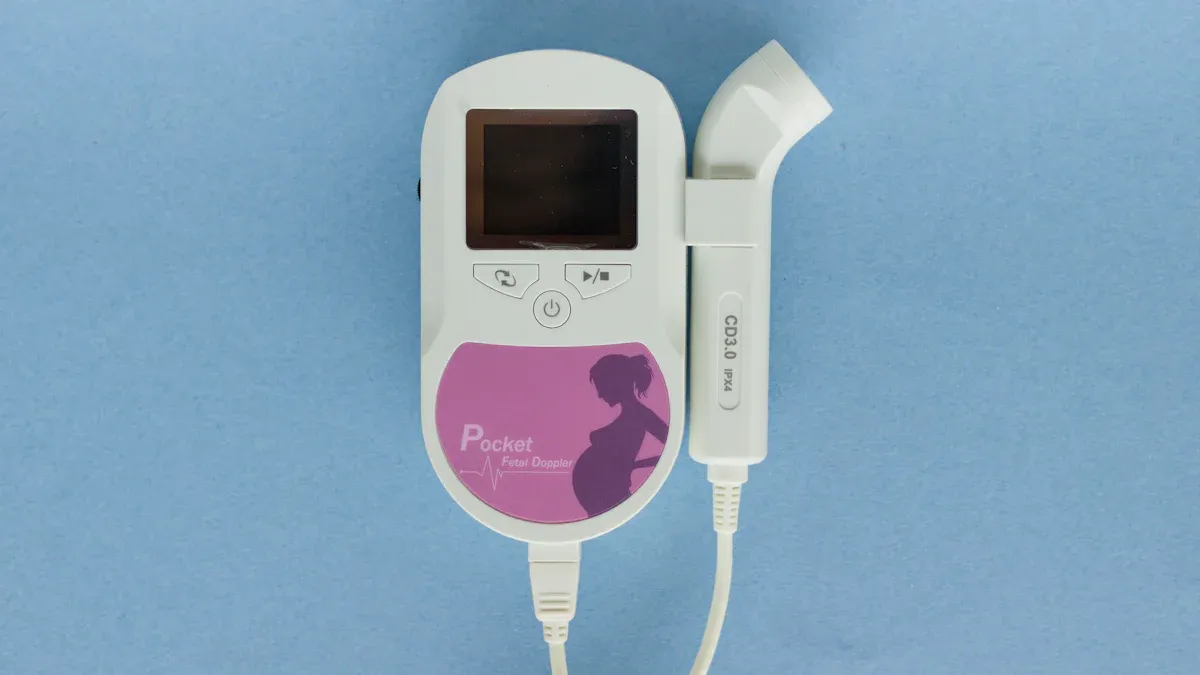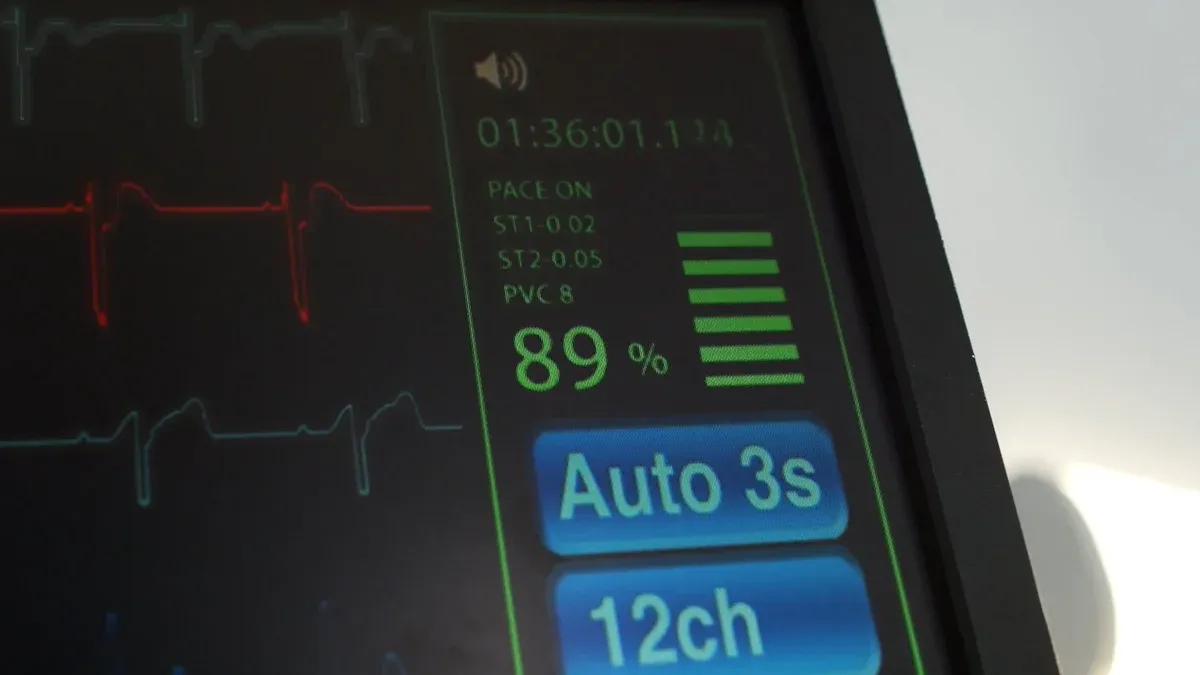
Reliable ECG monitor batteries play a critical role in heart monitoring and patient care. You depend on consistent battery life to ensure uninterrupted ECG data collection and accurate health assessments. Poor battery performance can interrupt monitoring, increase the risk of data loss, and expose sensitive patient information to security threats.
When the battery in your monitor fails, it can compromise both data accuracy and the safety of heart patients.
You must prioritize battery maintenance to protect data integrity and support continuous health monitoring.
Key Takeaways
Reliable ECG monitor batteries are essential for uninterrupted heart monitoring and accurate data collection.
Regularly assess battery performance to prevent data loss and ensure patient safety during monitoring.
Use high-quality lithium batteries like LiFePO4 or NMC for longer life and stable power output.
Implement strict maintenance protocols and staff training to enhance battery management and emergency response.
Stay updated on battery technology advancements to improve patient outcomes and device reliability.
Part 1: ECG Monitor Batteries and Device Stability

1.1 Battery Life and Continuous Monitoring
You rely on strong battery life to keep ECG monitor batteries running without interruption. In heart monitoring, even a short power loss can disrupt data collection and put patient care at risk. Studies show that battery life directly affects device stability. If the battery in your monitor drains too quickly, you may lose critical ECG data or face gaps in continuous monitoring. Frequent charging can also reduce the effectiveness of heart monitoring devices, especially during long-term health assessments. Consistent electrode-skin contact and stable battery performance ensure that your monitor delivers reliable results for both patient safety and data accuracy.
1.2 Lithium Polymer Battery Advantages
Lithium polymer batteries stand out as the preferred choice for ECG monitor batteries. You benefit from their high energy density, which allows for compact designs and longer operation times. These batteries offer stable power output, which is essential for heart monitoring devices that require continuous and accurate data. Their built-in safety features help prevent overheating and short circuits, making them reliable for medical applications.
Here is a comparison of common lithium battery chemistries used in ECG monitors and related sectors:
Chemistry | Platform Voltage (V) | Energy Density (Wh/kg) | Cycle Life (cycles) | Application Scenarios |
|---|---|---|---|---|
LiFePO4 | 3.2 | 90–160 | 2000–7000 | Medical, robotics, infrastructure |
NMC | 3.7 | 150–220 | 1000–2000 | Medical, security, consumer electronics |
LCO | 3.7 | 150–200 | 500–1000 | Medical, consumer electronics |
LMO | 3.7 | 100–150 | 300–700 | Medical, industrial |
LTO | 2.4 | 70–80 | 7000–20000 | Medical, infrastructure, industrial |
Solid-state | 3.7–4.2 | 250–500 | 1000–5000 | Medical, security, robotics |
Lithium metal | 3.4–3.7 | 350–500 | 500–1000 | Medical, security, robotics |
Tip: For advanced battery management, consider integrating a Battery Management System (BMS). Learn more about BMS and PCM.
1.3 Assessing Battery Performance
You should regularly assess the performance of your ECG monitor batteries to maintain device stability and support heart monitoring. Use these best practices:
Monitor battery health through built-in diagnostics.
Schedule routine checks for battery life and charging cycles.
Replace batteries that show signs of reduced capacity or irregular performance.
Train your health care staff to recognize early warning signs of battery failure.
By following these steps, you help ensure reliable heart monitoring and protect patient health.
Part 2: Battery Life and Patient Safety

2.1 Power Supply Reliability
You depend on reliable battery life to maintain patient safety and continuous operation in ECG monitoring. When you use high-quality lithium battery packs, such as LiFePO4 or NMC, you benefit from longer operational times and stable voltage. This reliability ensures that your monitor does not unexpectedly shut down during heart monitoring, which could compromise both data accuracy and patient care. Regulatory standards require ECG monitor batteries to perform safely, even under low-battery conditions. Devices like pacemakers and drug delivery pumps must alert you or enter a safe mode before battery depletion. The table below highlights the relationship between battery longevity and patient safety:
Aspect | Explanation |
|---|---|
Battery Longevity | Directly impacts the safety and functionality of medical devices. |
Regulatory Standards | Require devices to demonstrate essential performance even under low-battery conditions. |
Patient Safety | Ensures that devices do not compromise patient safety, such as entering safe modes when battery is low. |
Example Devices | Pacemakers and drug delivery pumps must issue alarms or enter safe modes before battery depletion. |
Surgical Risks | Longer-lasting batteries reduce the frequency of replacement surgeries, minimizing patient risk. |
2.2 Preventing Downtime in Continuous Monitoring
You can prevent downtime in continuous ECG monitoring by following best practices for battery management. Common causes of downtime include battery failure, power interruptions, and low battery levels. These issues can disrupt ECG recordings and threaten data security and data accuracy. To reduce these risks, you should:
Test equipment battery life regularly.
Keep spare batteries available for immediate replacement.
Inspect power cords and connections for wear or damage.
Follow recommended charging schedules for your monitor.
Prepare emergency monitoring supplies to ensure uninterrupted heart monitoring.
By taking these steps, you help maintain data security and protect patient health.
2.3 Maintenance Protocols
You extend the life of your ECG monitor batteries and support patient safety by implementing strict maintenance protocols. Regularly check the battery’s charge before each use. Schedule annual battery replacements if your monitor sees frequent use. Avoid unnecessary shocks to the device and ensure it is programmed for optimal energy use. Encourage patients to follow lifestyle recommendations from healthcare providers, as excessive physical activity can lead to frequent device firing and faster battery depletion. Routine checkups with a cardiologist help you monitor device performance and maintain data accuracy. Consistent maintenance supports both heart health and the integrity of your ECG data, while also reinforcing data security through reliable device operation and encryption.
Part 3: Data Security and Data Accuracy
3.1 Risks from Battery Failure
You face significant risks to data security and accuracy when battery failure occurs in ECG monitor batteries. An unstable power supply can lead to inaccurate data readings, which may result in misdiagnosis or improper clinical decisions. Device failure can compromise the security of sensitive health data, increasing privacy concerns and the risk of data breaches. Battery degradation over time threatens sensor performance, especially in clinical environments where you must comply with strict performance standards.
You must prioritize battery health to maintain real-time data integrity and protect patient information during heart monitoring.
Key risks from battery failure include:
Inaccurate real-time measurements and loss of critical ECG data
Increased vulnerability to data breaches and privacy concerns
Reduced sensor performance, impacting clinical decision-making and patient care
3.2 Protecting Data During Power Loss
You need robust strategies to protect data during unexpected power loss in ECG monitors. Real-time data collection depends on a stable battery and secure data handling protocols. You should implement automatic data backup systems that store ECG readings before battery depletion. Encryption of data transmission and storage helps safeguard patient information against unauthorized access.
Tip: Regularly test your monitor’s emergency power features and backup protocols to ensure continuous heart monitoring and data protection.
Best practices for data protection:
Use lithium battery packs with integrated Battery Management Systems (BMS) for reliable power supply
Schedule routine vulnerability assessments and security audits
Apply user authentication protocols to restrict access to sensitive health data
Maintain secure network connections for real-time data transfer
3.3 Compliance and Secure Communication
You must comply with strict regulatory standards to ensure data security in ECG monitoring devices. Regulations such as HIPAA in the United States and GDPR in Europe set requirements for the protection of identifiable health information. These standards mandate encryption, secure communication, and regular security audits for ECG monitor batteries and related systems.
Regulation | Region | Key Points |
|---|---|---|
HIPAA | United States | Establishes national standards for the protection of identifiable health information, including specific security measures for electronic health data. |
GDPR | Europe | Provides extensive rights to data subjects regarding their personal data, mandates data protection by design and default, and imposes strict penalties for non-compliance. |
You must implement data transmission and storage encryption, user authentication, and secure network connections to meet compliance requirements. As ECG machines become more connected, you need to address privacy concerns and ensure patient data integrity.
Note: If your business sources lithium battery packs, review your supply chain for conflict minerals compliance. Conflict Minerals Statement
You support patient care and clinical accuracy by maintaining secure communication and adhering to regulatory standards. Reliable ECG monitor batteries help you deliver accurate real-time measurements and protect sensitive health data in every heart monitoring scenario.
Part 4: Best Practices for ECG Monitor Batteries
4.1 Monitoring Battery Health
You need to monitor battery health consistently to ensure your ECG monitor delivers reliable results. Regular checks help you detect early signs of battery degradation, such as reduced capacity or irregular charging cycles. Use built-in diagnostics to track performance and schedule preventive maintenance. Many organizations set up automated alerts for low battery levels, which helps you avoid unexpected downtime during heart monitoring.
Tip: Integrate a Battery Management System (BMS) to optimize charging, extend battery life, and enhance safety. Learn more about BMS and PCM.
Best practices for battery management:
Schedule monthly battery performance reviews.
Replace batteries that show signs of swelling or rapid discharge.
Store spare lithium battery packs in a controlled environment.
Document all maintenance activities for compliance and audit purposes.
4.2 Staff Training and Emergency Response
You improve patient care and safety by investing in comprehensive staff training. Well-trained staff respond quickly to ECG monitor battery alarms and emergencies. Training programs should cover alarm management, device operation, and emergency protocols.
Staff with proper training customize alarm settings and reduce alarm fatigue, which improves patient outcomes.
Many teams report a lack of training on monitoring equipment, highlighting the need for ongoing education.
Provide hands-on, device-specific training for all staff, with refreshers every three months in low-use areas.
Note: Regular competency assessments ensure your team remains prepared for any battery-related emergency.
4.3 Innovations in Battery Technology
You benefit from recent advances in ECG monitor battery technology. Devices like the Kardia 12L now offer lightweight, portable solutions for heart monitoring, requiring minimal training and improving patient comfort. New insertable monitors, such as Assert-IQ, use long-lasting lithium battery packs and Bluetooth connectivity for seamless data transmission.
Device | Battery Life | Technology | Usability | Monitoring Features |
|---|---|---|---|---|
Kardia 12L | Battery-operated | Portable | Weighs 0.3 lbs, easy to use | Minimal training, less invasive for patients |
Assert-IQ | Extended use | Bluetooth-enabled | Inserted under skin, supports daily life | Monitors heart rhythms every 20 seconds, remote data |
You can expect further improvements in energy density, cycle life, and safety features as lithium battery chemistries evolve. These innovations support continuous health monitoring and help you deliver better patient outcomes.
Choosing high-quality lithium battery packs for your ECG healthcare device supports stable heart monitoring and protects sensitive patient data. Regular battery assessments and ongoing staff training improve patient outcomes, as shown below:
Practice | Impact on Patient Outcomes |
|---|---|
Technician training and competency reviews | Accurate dysrhythmia interpretation and timely response |
Immediate alerts for alarms or maintenance | Fewer missed alarms and better patient safety |
Staying updated on battery technology trends extends device longevity and enhances health monitoring. You strengthen your organization’s reliability by following best practices for battery management and continuous monitoring.
FAQ
What lithium battery chemistries are best for ECG monitors in clinical settings?
You should consider LiFePO4 and NMC for ECG monitors. These chemistries offer stable platform voltage, high energy density, and long cycle life.
Chemistry | Platform Voltage (V) | Energy Density (Wh/kg) | Cycle Life (cycles) | Medical Use |
|---|---|---|---|---|
LiFePO4 | 3.2 | 90–160 | 2000–7000 | Yes |
NMC | 3.7 | 150–220 | 1000–2000 | Yes |
How does battery management impact patient-centered care?
You improve patient-centered care by monitoring battery health and using a Battery Management System (BMS). This ensures uninterrupted ECG monitoring and accurate data collection.
Tip: Learn more about BMS and PCM for medical devices.
What protocols help secure ECG data during power loss?
You should implement automatic data backup and encryption protocols. These measures protect ECG data over time and reduce the risk of breaches during unexpected battery failures.
Use integrated BMS for reliable power.
Schedule regular security audits.
How do you ensure sustainability and compliance in lithium battery sourcing?
You must review your supply chain for conflict minerals and environmental impact.
Note: See the Conflict Minerals Statement for compliance guidance.
Why is cycle life important for ECG monitor batteries in business operations?
You rely on long cycle life to reduce maintenance costs and downtime. Batteries with high cycle life, such as LiFePO4 and LTO, support continuous monitoring and reliable data over time in medical environments.




